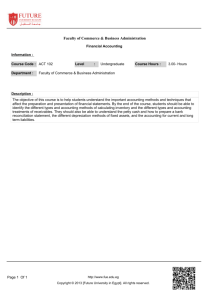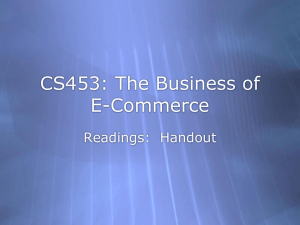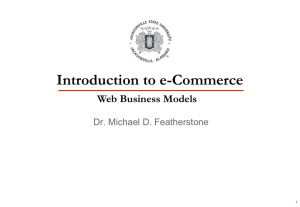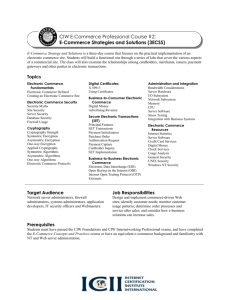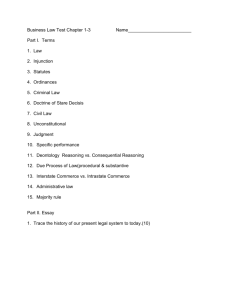The Emerging World of E Commerce
advertisement
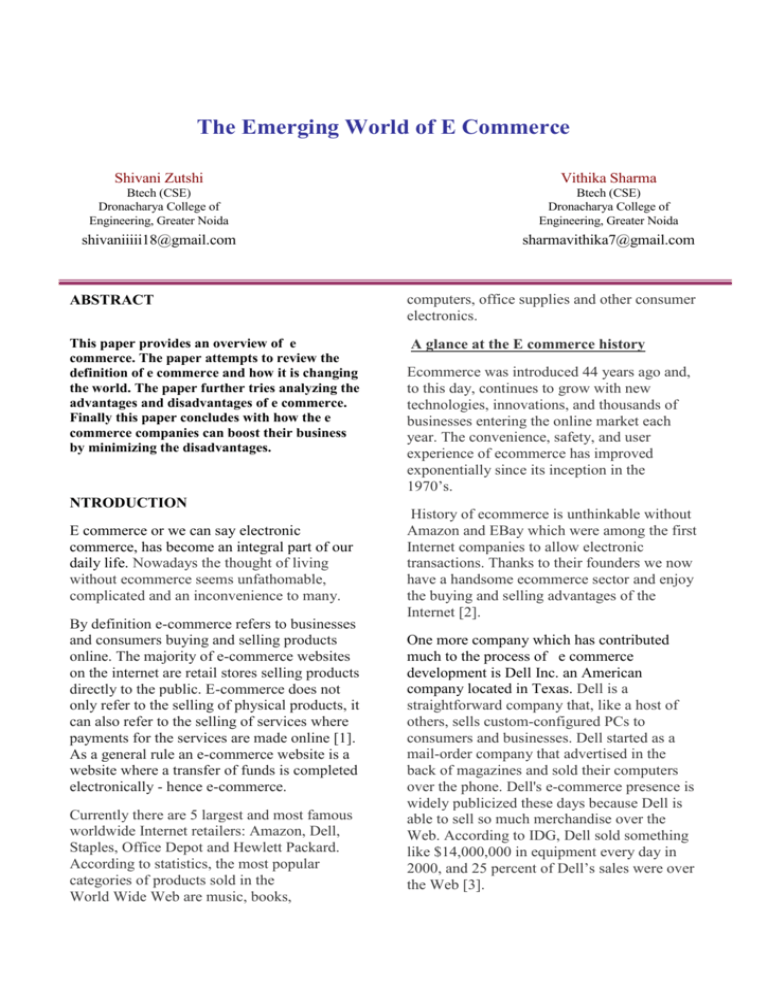
The Emerging World of E Commerce Shivani Zutshi Vithika Sharma Btech (CSE) Dronacharya College of Engineering, Greater Noida Btech (CSE) Dronacharya College of Engineering, Greater Noida shivaniiiii18@gmail.com sharmavithika7@gmail.com ABSTRACT computers, office supplies and other consumer electronics. This paper provides an overview of e commerce. The paper attempts to review the definition of e commerce and how it is changing the world. The paper further tries analyzing the advantages and disadvantages of e commerce. Finally this paper concludes with how the e commerce companies can boost their business by minimizing the disadvantages. A glance at the E commerce history NTRODUCTION E commerce or we can say electronic commerce, has become an integral part of our daily life. Nowadays the thought of living without ecommerce seems unfathomable, complicated and an inconvenience to many. By definition e-commerce refers to businesses and consumers buying and selling products online. The majority of e-commerce websites on the internet are retail stores selling products directly to the public. E-commerce does not only refer to the selling of physical products, it can also refer to the selling of services where payments for the services are made online [1]. As a general rule an e-commerce website is a website where a transfer of funds is completed electronically - hence e-commerce. Currently there are 5 largest and most famous worldwide Internet retailers: Amazon, Dell, Staples, Office Depot and Hewlett Packard. According to statistics, the most popular categories of products sold in the World Wide Web are music, books, Ecommerce was introduced 44 years ago and, to this day, continues to grow with new technologies, innovations, and thousands of businesses entering the online market each year. The convenience, safety, and user experience of ecommerce has improved exponentially since its inception in the 1970’s. History of ecommerce is unthinkable without Amazon and EBay which were among the first Internet companies to allow electronic transactions. Thanks to their founders we now have a handsome ecommerce sector and enjoy the buying and selling advantages of the Internet [2]. One more company which has contributed much to the process of e commerce development is Dell Inc. an American company located in Texas. Dell is a straightforward company that, like a host of others, sells custom-configured PCs to consumers and businesses. Dell started as a mail-order company that advertised in the back of magazines and sold their computers over the phone. Dell's e-commerce presence is widely publicized these days because Dell is able to sell so much merchandise over the Web. According to IDG, Dell sold something like $14,000,000 in equipment every day in 2000, and 25 percent of Dell’s sales were over the Web [3]. the shoemaker to the retailer would be considered a (B2B) transaction. While the term e-commerce refers to all online transactions, B2C stands for "businessto-consumer" and applies to any business or organization that sells its products or services to consumers over the internet for its own use [5]. History of ecommerce is a history of a new, virtual world which is evolving according to the customer advantage. It is a world which we are all building together brick by brick, laying a secure foundation for the future generations. 2. Types of E commerce: Consumer to Business(C2B): C2B is an e commerce business model in which consumers (individuals) offer products and services to companies and the companies pay them. This business model is a complete reversal of traditional business model where companies offer goods and services to consumers. We can see this example in blogs or internet forums where the author offers a link back to an online business facilitating the purchase of some product (like a book on Amazon.com), and the author might receive affiliate revenue from a successful sale [6]. Another example where a consumer posts his project with a set budget online and within hours companies review the consumer's requirements and bid on the project. The consumer reviews the bids and selects the company that will complete the project [7]. Consumer to Consumer (C2C): C2C e commerce involves the electronically facilitated transactions between consumers through some third party. There are many sites offering free classifieds, auctions, and forums where individuals can buy and sell thanks to online payment systems like PayPal where people can send and receive money online with ease. EBay’s auction service is a great example of where person-to-person transactions take place everyday since 1995. The major E commerce types are- Business to Business (B2B): B2B describes commerce transactions between businesses, such as between a manufacturer and a wholesaler, or between a wholesaler and a retailer. About 80% of e-commerce is of this type, and most experts predict that B2B e-commerce will continue to grow faster than the B2C (i.e. Business 2 Consumer) segment. Most B2B applications are in the areas of supplier management (especially purchase order processing), inventory management (i.e., managing order-ship-bill cycles), distribution management (especially in the transmission of shipping documents), channel management (i.e., information dissemination on changes in operational conditions), and payment management (e.g., electronic payment systems or EPS) [4]. Business to Consumer (B2C): B2C describes activities of businesses serving end consumers with products and/or services. An example of a B2C transaction would be a person buying a pair of shoes from a retailer. The transactions that led to the shoes being available for purchase, which is the purchase of the leather, laces, rubber, etc. However, the sale of the shoe from There are other forms of ecommerce that involve transactions with the government-from procurement to filing taxes to business registrations to renewing licenses. G2G (Government-to-Government), G2E (Government-to-Employee), G2B (Government-to-Business), B2G (Businessto-Government), G2C (Government-toCitizen), C2G (Citizen-to-Government). 3. Pros and Cons of E commerce: the week, and every week of the year. Your receptionist, greeter and front people are always working for you because they are your website. They do not complain about the long hours. Messages spreading (world wide market space) – advertising on the web can make a big or small firm’s promotional message reach out to potential customers all over the world quickly and at a small cost . ProsTime saving – the number one reason for using electronic commerce. People now have access to their money and what they need to buy from home and work all from a desktop computer. Consumers have an access to a wider range of products – company now can use internet sites as shop fronts, so consumers can browse, buy from many different sellers and making it easier to find exactly what they are looking for. Allows small businesses to mix with the big business online – with a relatively small cost, a new business can set its self up to conduct transactions online. Provide benefits to suppliers of goods and services – company now can target a wider variety of consumers; even take the product or service international, allowing them a means of supplying their goods to places that were before unreachable. Business is Open 24 x 7 x 364 7/8 – it works while you play or sleep. They are open for business every hour of the day, every day of Thinking Outside the Globe – selling something made by someone else shipped by yet another and the money handled by yet another is the heart of the advantages e commerce brings to the business world. You can even employ an international staff. Some work you may need done can be more effectively done by companies or even individuals in other countries. Cons- Purchase to Delivery – when making a purchase at a brick and mortar business, you get the product when you pay for it. On the web, there may be a time lag from purchase to actually being able to consume. The consumer will have to wait for delivery of physical goods. Inability to Feel the Physical – it is nearly impossible to sell things like furniture and tires online. Furniture is something people like to sit on and know the feel. Tires need to be installed once purchased. In both instances, there is a need for real actions to fulfill the reason for the purchase. Return-on-investment is difficult to calculate [8]. Trouble recruiting and retaining employees – the company needs well-expert and skilled staff to keep up and create the ecommerce facilities of the company. Many companies favour to outsource their improvement and programming tasks to decrease labour costs [9]. Consumers feel less confident with their credit card numbers – most of the consumers are still not confident in providing their credit card numbers for making payments on the website while shopping on the Internet. There is no guarantee of product quality. Not every company can take the benefit – some of the small companies may not be able to take the benefit of E commerce for example the lack of expertise and lack of technology. The legal environment in which E-commerce is conducted is full of unclear and conflicting laws. It should be noted that mostly these disadvantages stem from the newness and rapidly growth of the technology. Larger purchases per transaction – For example many sites offer a feature that when you read the description of a book, you also can see "what other people who ordered this book also purchased." That is, you can see the related books that people are actually buying. Because of features like these it is common for people to buy more books that they might buy at a normal bookstore. Improved customer interactions - With automated tools it is possible to interact with a customer in richer ways at virtually no cost. For example, the customer might get an email when the order is confirmed, when the order is shipped and after the order arrives. A happy customer is more likely to purchase something else from the company. It is these sorts of advantages that create the buzz that surrounds e commerce right now. The back end: fulfillment, returns, customer service - These processes make or break any retail establishment. They define, in a big way, your relationship with your customer. Affiliate Programs 4. How E commerce companies can boost their business: Lower transaction costs - if an e commerce site is implemented well, the web can significantly lower both order-taking costs up front and customer service costs after the sale by automating processes. A big part of today's e-commerce landscape is the affiliate program (also known as associate programs). This area was pioneered by Amazon. Amazon allows anyone to set up a specialty book store. When people buy books from the specialty store, the person who owns the specialty bookstore gets a commission (up to 10 percent of the book's list price) from Amazon. The affiliate program gives Amazon great exposure because it now has over 1,000,000 specialty bookstores all over the Web. Therefore this model is now copied by thousands of e-commerce sites. If you are setting up an e-commerce site you will want to consider an affiliate program as one way to get exposure. Another twist on affiliate programs is the CPC Link (CPC=Cost Per Click), also known as affiliate links or click-thru links. You put a link on your site and the company pays you when someone clicks on the link. A typical payment ranges from 5 cents to 20 cents per click. You may want to consider setting up this sort of affiliate program to gain exposure for your e-commerce site. Payment details, you can almost be sure that you will lose them as a customer almost instantly. (Your competitors are just a click away, always.) If you are selling internationally, use a service recognized worldwide, e.g. PayPal or Worldpay. If you are selling locally, use whatever service that is well known, trustworthy and convenient in that particular country. Lastly, don’t forget to put up related Payment Gateway Logo on your website! Survey shows that more than 80% consumers feel safer seeing all these logo prominently displayed on your store. (Note: Use the logo only if the store support the payment type) [11]. Simply the checkout processYou’ve heard it a million times: Keep it simple. Why, then, do so many businesses make it difficult to buy from them? Ask the customers to create an account after checkout. Many businesses don’t realize that asking customers to register accounts can actually increase cart abandonment. Most people resent having to create another account online: It is one more username and one more password to keep track of and many perceive that an account will sign them up for spammy emails and newsletters. According to study findings by Smashing Magazine, every study participant showed frustration when asked to register an account during checkout and 30 percent of them gave up and abandoned their cart altogether. Instead of asking customers to register an account with your site, include it as an option only after they have completed the purchase and checkout process [10]. Use a Reputable Payment Gateway Serviceif the online customers have a single doubt about the security of the payment gateways you are using to process their Credit Card or Future Scope: In this paper we looked at the definition of e commerce its history. Then we looked at the different types of e commerce. Finally we provided with different ways to increase the e commerce business. The future scope definitely lies in making the E commerce business safe and that can be partly achieved if the customers also pay some attention and try to avoid getting caught in the attacker’s trap. The organizations should educate the employees operating within the organization. They should have an understanding of the fraud and security risks involved in an eCommerce transaction. They should also have in-depth knowledge of the organizations e commerce risk management policies and procedures. The more informed an organization is, the easier it will be to combat online threats and to carry out risk mitigating measures. There are a no. of ways in which the security can be improved. And at the same time there a no. of ways in which the security can be compromised too. So we hope that we get a secure e commerce world in the near future. REFERENCES [1] Definition of E commerce- wikipedia [2] http://www.ecommerceland.com/history_ecommerce.html [3]http://money.howstuffworks.com/ecommer ce4.htm [4] Business 2 Business – wikipedia. [5] [6] Taking a look at different types of e commerce – by Rania Nemat World Applied Programming, Vol (1), No (2), June 2011. 100-104 ISSN: 2222-2510 ©2011 WAP journal. [7]http://www.digitsmith.com/ecommercedefinition.html [8] [9] Disadvantages of E commerce – Wikipedia. [10]http://blog.crazyegg.com/2013/11/28/boos t-e-commerce-traffic-sales/ [11]http://www.webshaper.com.my/learn/top10-ways-build-trust-online.php I SECTIONS The heading of a section should be in Times New Roman 12-point bold in all-capitals flush left with an additional 6-points of white space above the section head. Sections and subsequent subsections should be numbered and flush left. For a section head and a subsection head together (such as Section 3 and subsection 3.1), use no additional space above the subsection head. Subsections The heading of subsections should be in Times New Roman 12-point bold with only the initial letters capitalized. (Note: For subsections and subsubsections, a word like the or a is not capitalized unless it is the first word of the header.) Subsubsections The heading for subsubsections should be in Times New Roman 11-point italic with initial letters capitalized and 6-points of white space above the subsubsection head. Subsubsections The heading for subsubsections should be in Times New Roman 11-point italic with initial letters capitalized. Subsubsections The heading for subsubsections should be in Times New Roman 11-point italic with initial letters capitalized. [1] Bowman, M., Debray, S. K., and Peterson, L. L. 1993. Reasoning about naming systems. . [2] Ding, W. and Marchionini, G. 1997 A Study on Video Browsing Strategies. Technical Report. University of Maryland at College Park. [3] Fröhlich, B. and Plate, J. 2000. The cubic mouse: a new device for three-dimensional input. In Proceedings of the SIGCHI Conference on Human Factors in Computing Systems [4] Tavel, P. 2007 Modeling and Simulation Design. AK Peters Ltd. [5] Sannella, M. J. 1994 Constraint Satisfaction and Debugging for Interactive User Interfaces. Doctoral Thesis. UMI Order Number: UMI Order No. GAX95-09398., University of Washington. [6] Forman, G. 2003. An extensive empirical study of feature selection metrics for text classification. J. Mach. Learn. Res. 3 (Mar. 2003), 1289-1305. [7] Brown, L. D., Hua, H., and Gao, C. 2003. A widget framework for augmented interaction in SCAPE. [8] Y.T. Yu, M.F. Lau, "A comparison of MC/DC, MUMCUT and several other coverage criteria for logical decisions", Journal of Systems and Software, 2005, in press. Spector, A. Z. 1989. Achieving application requirements.
